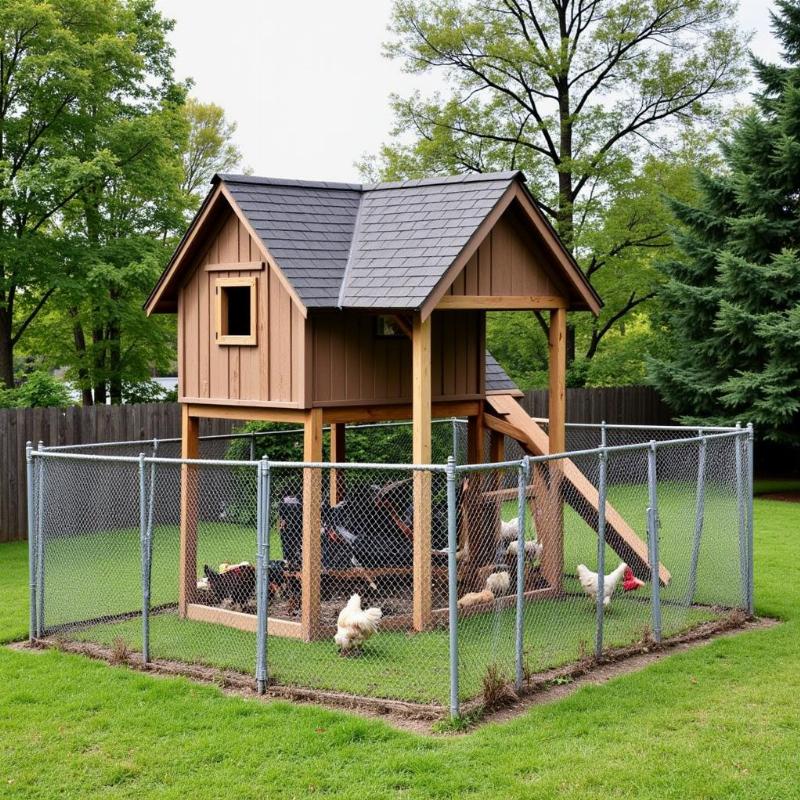Keeping your dog from turning your backyard coop into a feathered buffet is a common concern for chicken owners. This guide offers practical, humane solutions to help you integrate your canine and poultry pals peacefully. Whether you have a seasoned chicken-chaser or a curious pup, understanding the root of the behavior is the first step to achieving backyard harmony. We’ll explore training techniques, preventative measures, and management strategies to ensure both your chickens and your dog are safe and happy.
Understanding the Prey Drive
Dogs, even the fluffiest lap dogs, have an inherent prey drive. This instinctual urge to chase and sometimes kill smaller animals is a remnant of their wild ancestors. Some breeds, like terriers and hounds, have a stronger prey drive than others, making them more prone to chicken-chasing shenanigans. However, any dog can develop a taste for feathered pursuits. Recognizing this instinct is crucial for effectively addressing the issue.
Training Your Dog to Leave Chickens Alone
Training is the cornerstone of preventing chicken casualties. Consistency and positive reinforcement are key. Here’s a step-by-step approach:
- Basic Obedience: A solid foundation in basic commands like “sit,” “stay,” and “come” is essential. These commands give you control over your dog’s behavior, even when distractions are present.
- Introduce the Chickens Gradually: Start by having your dog on a leash and allowing them to observe the chickens from a safe distance. Reward calm behavior with praise and treats.
- Reinforce “Leave It” Command: Use the “leave it” command whenever your dog shows interest in the chickens. If they look away, reward them. Gradually decrease the distance between your dog and the chickens as they consistently respond to the command.
- Correction and Redirection: If your dog lunges or barks at the chickens, use a firm “no” and redirect their attention with a toy or another command.
- Supervised Interactions: Once your dog demonstrates consistent self-control, allow short, supervised interactions with the chickens. Keep your dog on a leash and monitor their behavior closely.
Preventative Measures: Creating a Safe Environment
Creating a physical barrier between your dog and your chickens can provide peace of mind and prevent unwanted interactions.
- Fencing: A secure fence around the chicken coop is essential. Ensure it’s tall enough and buried deep enough to prevent digging escapes.
- Separate Play Areas: Designate separate, fenced areas for your dog and chickens to enjoy their own space. This minimizes the temptation for chasing and ensures everyone has a safe haven.
 Chuồng gà an toàn
Chuồng gà an toàn
Management Strategies for Long-Term Success
Long-term success relies on consistent management strategies and vigilance.
- Supervise Outdoor Time: Never leave your dog unsupervised with your chickens, even if they seem to have mastered the “leave it” command. Accidents can happen, and it’s better to be safe than sorry.
- Provide Enrichment: A bored dog is more likely to engage in undesirable behaviors like chicken chasing. Provide plenty of exercise, mental stimulation, and interactive toys to keep your dog entertained and satisfied.
- Consider a Muzzle: In some cases, particularly with dogs with a very high prey drive, a muzzle may be a necessary safety precaution during initial training or supervised interactions.
“Consistent training and management are the keys to integrating dogs and chickens successfully. Don’t get discouraged if it takes time and patience. The reward of a peaceful backyard is worth the effort,” advises Dr. Emily Carter, DVM, a specialist in animal behavior.
Conclusion
Stopping your dog from killing chickens requires a multi-faceted approach that combines training, prevention, and management. By understanding your dog’s instincts and implementing these strategies, you can create a harmonious environment where both your canine companion and your feathered friends can thrive. Remember, patience and consistency are crucial for long-term success.
FAQ
- Is it possible to train any dog to leave chickens alone? Most dogs can be trained, but those with extremely high prey drives may require more intensive training and management.
- What if my dog has already killed a chicken? It’s crucial to prevent further incidents by immediately implementing the training and preventative measures outlined above.
- How long does training usually take? The training timeline varies depending on the dog, but consistency is key. It can take weeks or even months to achieve reliable results.
- Are certain breeds more prone to chicken chasing? Yes, breeds with strong hunting instincts, like terriers and hounds, may be more inclined to chase.
- What if my dog only chases but doesn’t kill the chickens? Chasing is still stressful for the chickens and can lead to injuries. Implement the same training strategies to discourage chasing behavior.
- Can I use punishment to stop my dog from killing chickens? Punishment is generally ineffective and can worsen the problem. Focus on positive reinforcement and redirection instead.
- My dog ignores the “leave it” command around chickens. What should I do? Go back to basics and reinforce the command in less distracting environments. Gradually reintroduce the chickens once your dog has a stronger understanding of the command.
Related Articles on Beautdogs.us
(Please add links to relevant articles on your website here if applicable.)
About Beautdogs.us
Beautdogs.us is your premier online resource for all things dog-related in the USA. We offer expert advice on dog breeds, care, training, and product reviews, empowering you to provide the best possible care for your canine companion. Whether you’re a seasoned dog owner or just starting your journey, Beautdogs.us provides reliable information and resources to help you navigate the wonderful world of dog ownership. Contact us for any inquiries at [email protected] or call us at +1 501-555-7529.